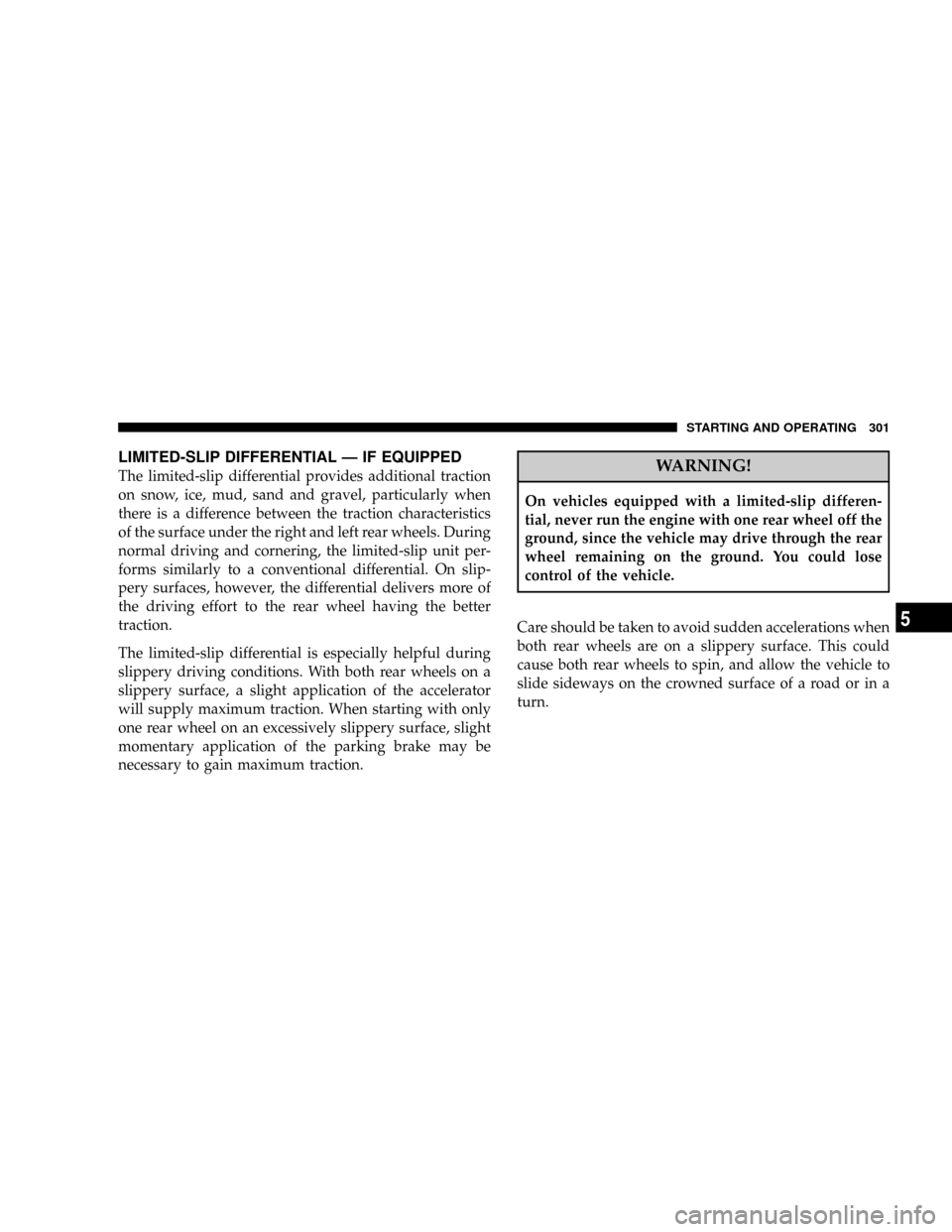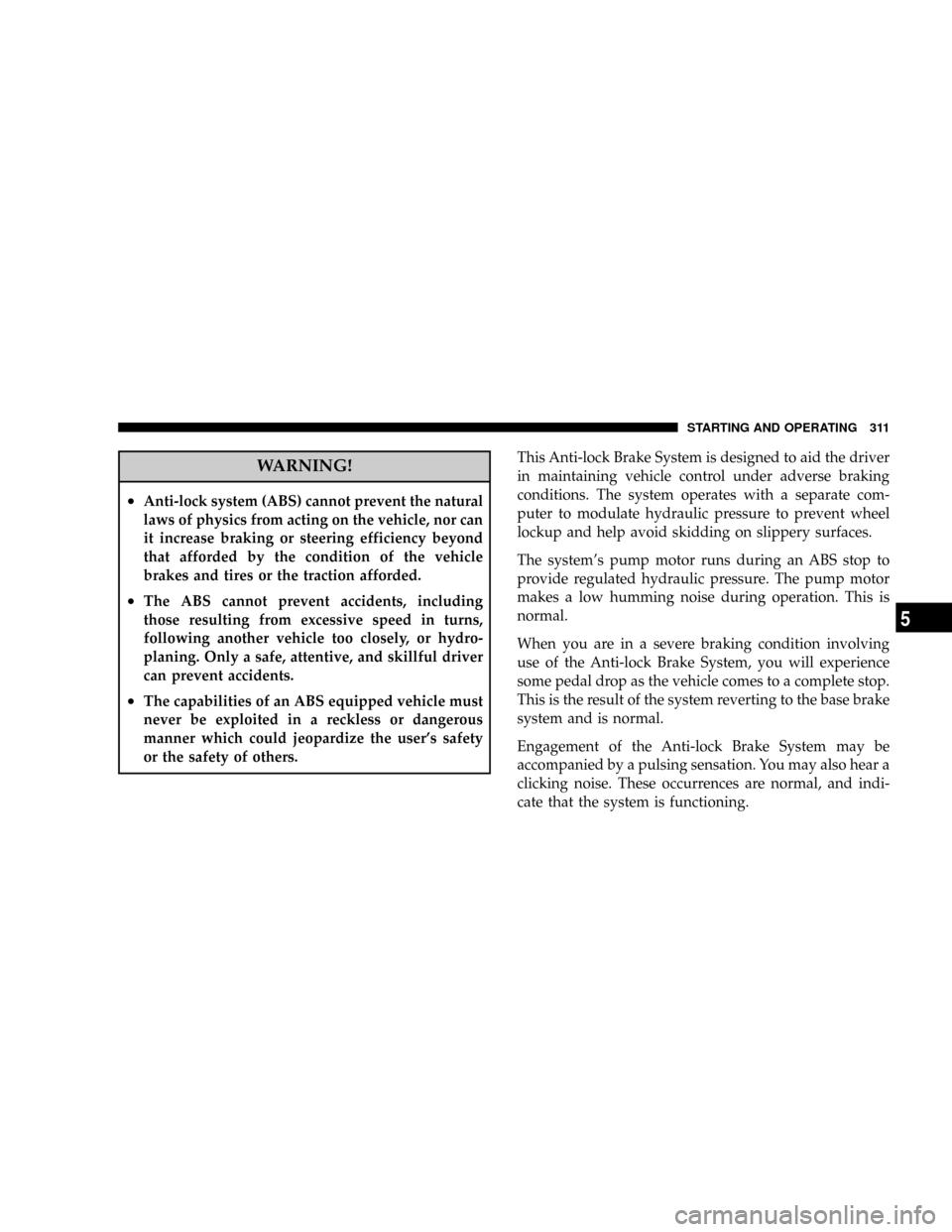traction control DODGE RAM 3500 CHASSIS CAB 2008 3.G Owners Manual
[x] Cancel search | Manufacturer: DODGE, Model Year: 2008, Model line: RAM 3500 CHASSIS CAB, Model: DODGE RAM 3500 CHASSIS CAB 2008 3.GPages: 528, PDF Size: 7.84 MB
Page 59 of 528

²Airbag deployment level (if applicable)
²Impact acceleration and angle
²Seatbelt status
²Brake status (service and parking brakes)
²Accelerator status (including vehicle speed)
²Engine control status (including engine speed)
²Transmission gear selection
²Cruise control status
²Traction/stability control status
²Tire pressure monitoring system status (if equipped)
Child Restraint
Everyone in your vehicle needs to be buckled up all the
time Ð babies and children, too. Every state in the United
States and all Canadian provinces require that small
children ride in proper restraint systems. This is the law,
and you can be prosecuted for ignoring it.
Children 12 years and under should ride properly buck-
led up in a rear seat, if available. According to crash
statistics, children are safer when properly restrained in
the rear seats rather than in the front.
THINGS TO KNOW BEFORE STARTING YOUR VEHICLE 59
2
Page 181 of 528

Acceleration which causes the rear wheels to slip for a
period of time may result in the red brake light illumi-
nating and a brake switch code being set on ABS
equipped vehicles. Depressing the brake pedal should
extinguish the red brake light.
20. ABS Warning Light
This light monitors the Anti-Lock Brake System
which is described elsewhere in this manual. This
light will come on when the ignition key is turned to the
ON position and may stay on for five seconds. If the ABS
light remains on or comes on during driving, it indicates
that the anti-lock portion of the brake system is not
functioning and that service is required. See your autho-
rized dealer immediately. The ABS light could also
illuminate during loss of traction and remain illuminated
until the brake pedal is pressed.21. Electronic Throttle Control (ETC)
This light informs you of a problem with the
Electronic Throttle Control system. If a prob-
lem is detected the light will come on while the
engine is running. If the light remains lit with
the engine running your vehicle will usually be drivable,
however, see your dealer for service as soon as possible.
If the light is flashing when the engine is running,
immediate service is required and you may experience
reduced performance, an elevated/rough idle or engine
stall and your vehicle may require towing. The light will
come on when the ignition is first turned on and remain
on for 15 seconds as a bulb check. If the light does not
come on during starting, have the system checked by an
authorized dealer.
22. SERV 4WD Indicator
The 4WD indicator will be illuminated whenever the
4WD mode is engaged for either the manual or electric
shift 4WD systems. The SERV 4WD indicator monitors
UNDERSTANDING YOUR INSTRUMENT PANEL 181
4
Page 294 of 528

Electronically Shifted Transfer Case Operating
Information/Precautions (4 Position Switch) Ð If
Equipped
This is an electric shift transfer case and is operated by
the 4WD Control Switch (Transfer Case Switch), which is
located on the instrument panel.This Electronically Shifted transfer case provides 4 mode
positions: 2 (rear) wheel drive high range, 4 wheel drive
lock range, 4 wheel drive low range, and neutral.
The Electronically Shifted transfer case is designed to be
driven in the 2 wheel drive position (2WD) for normal
street and highway conditions (dry hard surfaced roads).
When additional traction is required, the transfer case
4WD LOCK and 4WD LOW positions can be used to lock
the front and rear driveshafts together and force the front
and rear wheels to rotate at the same speed. This is
accomplished by rotating the 4WD Control Switch to the
desired position - see Shifting Procedure section for
specific shifting instructions. The 4WD LOCK and 4WD
LOW positions are designed for loose, slippery road
surfaces only. Driving in the 4WD LOCK and 4WD LOW
positions on dry hard surfaced roads may cause in-
creased tire wear and damage to the driveline compo-
nents.
Transfer Case Switch
294 STARTING AND OPERATING
Page 299 of 528

light will continue to flash until all the requirements for
the selected position have been met. To retry a shift:
return the control knob back to the original position,
make certain all shift requirements have been met, wait
five (5) seconds and try the shift again.
NOTE:If all the requirements to select a new transfer
case position have been met, the current position indica-
tor light will turn OFF, the selected position indicator
light will flash until the transfer case completes the shift.
When the shift is complete, the indicator light for the
selected position will stop flashing and remain ON.
2WD,4WD LOCK
Rotate the 4WD Control Switch to the desired position.
Shifts between 2WD and 4WD LOCK can be done with
the vehicle stopped or in motion. With the vehicle in
motion, the transfer case will engage / disengage faster if
you momentarily release the accelerator pedal after turn-
ing the control switch. If the vehicle is stopped, theignition key must be in the ON position with the engine
either RUNNING or OFF. This shift cannot be completed
if the key is in the accessory position.
NOTE:The 4x4 system will not allow shifts between
2WD/4WD LOCK if the front and/or rear wheels are
spinning (no traction). In this situation the selected
position indicator light will flash and the original posi-
tion indicator light will remain ON. At this time, reduce
speed and stop spinning the wheels to complete the shift.
2WD or 4WD LOCK,4WD LOW
NOTE:When shifting into or out of 4WD LOW some
gear noise may be heard. This noise is normal and is not
detrimental to the vehicle or occupants.
Shifting can be performed with the vehicle rolling 2 to 3
mph (3 to 5 km/h) or completely stopped. USE EITHER
OF THE FOLLOWING PROCEDURES:
STARTING AND OPERATING 299
5
Page 301 of 528

LIMITED-SLIP DIFFERENTIAL Ð IF EQUIPPED
The limited-slip differential provides additional traction
on snow, ice, mud, sand and gravel, particularly when
there is a difference between the traction characteristics
of the surface under the right and left rear wheels. During
normal driving and cornering, the limited-slip unit per-
forms similarly to a conventional differential. On slip-
pery surfaces, however, the differential delivers more of
the driving effort to the rear wheel having the better
traction.
The limited-slip differential is especially helpful during
slippery driving conditions. With both rear wheels on a
slippery surface, a slight application of the accelerator
will supply maximum traction. When starting with only
one rear wheel on an excessively slippery surface, slight
momentary application of the parking brake may be
necessary to gain maximum traction.WARNING!
On vehicles equipped with a limited-slip differen-
tial, never run the engine with one rear wheel off the
ground, since the vehicle may drive through the rear
wheel remaining on the ground. You could lose
control of the vehicle.
Care should be taken to avoid sudden accelerations when
both rear wheels are on a slippery surface. This could
cause both rear wheels to spin, and allow the vehicle to
slide sideways on the crowned surface of a road or in a
turn.
STARTING AND OPERATING 301
5
Page 311 of 528

WARNING!
²Anti-lock system (ABS) cannot prevent the natural
laws of physics from acting on the vehicle, nor can
it increase braking or steering efficiency beyond
that afforded by the condition of the vehicle
brakes and tires or the traction afforded.
²The ABS cannot prevent accidents, including
those resulting from excessive speed in turns,
following another vehicle too closely, or hydro-
planing. Only a safe, attentive, and skillful driver
can prevent accidents.
²The capabilities of an ABS equipped vehicle must
never be exploited in a reckless or dangerous
manner which could jeopardize the user's safety
or the safety of others.This Anti-lock Brake System is designed to aid the driver
in maintaining vehicle control under adverse braking
conditions. The system operates with a separate com-
puter to modulate hydraulic pressure to prevent wheel
lockup and help avoid skidding on slippery surfaces.
The system's pump motor runs during an ABS stop to
provide regulated hydraulic pressure. The pump motor
makes a low humming noise during operation. This is
normal.
When you are in a severe braking condition involving
use of the Anti-lock Brake System, you will experience
some pedal drop as the vehicle comes to a complete stop.
This is the result of the system reverting to the base brake
system and is normal.
Engagement of the Anti-lock Brake System may be
accompanied by a pulsing sensation. You may also hear a
clicking noise. These occurrences are normal, and indi-
cate that the system is functioning.
STARTING AND OPERATING 311
5
Page 506 of 528

DEPARTMENT OF TRANSPORTATION UNIFORM
TIRE QUALITY GRADES
The following describes the tire grading categories estab-
lished by the National highway Traffic Safety Adminis-
tration. The specific grade rating assigned by the tire's
manufacturer in each category is shown on the sidewall
of the tires on your car.
All Passenger Car Tires Must Conform to Federal Safety
Requirements in Addition to These Grades.
Treadwear
The treadwear grade is a comparative rating based on the
wear rate of the tire when tested under controlled con-
ditions on a specified government test course. For ex-
ample, a tire graded 150 would wear one and a half (1
1/2) times as well on the government course as a tire
graded 100. The relative performance of tires depends
upon the actual conditions of their use, however, andmay depart significantly from the norm due to variations
in driving habits, service practices and differences in road
characteristics and climate.
Traction Grades
The traction grades, from highest to lowest, are AA, A, B,
and C. Those grades represent the tire's ability to stop on
wet pavement as measured under controlled conditions
on specified government test surfaces of asphalt and
concrete. A tire marked C may have poor traction perfor-
mance.
WARNING!
The traction grade assigned to this tire is based on
straight-ahead braking traction tests, and does not
include acceleration, cornering, hydroplaning, or
peak traction characteristics.
506 IF YOU NEED CONSUMER ASSISTANCE
Page 525 of 528

Changing............................ 380
Dual............................336,386
General Information.................... 322
High Speed.......................... 327
Inflation Pressures..................... 323
Jacking............................. 380
Life of Tires.......................... 331
Load Capacity.....................318,319
Quality Grading....................... 506
Radial.............................. 328
Replacement......................... 331
Rotation............................. 335
Safety...........................313,322
Sizes............................... 315
Snow Tires........................... 334
Spinning............................ 329
Steel Carcass Ply....................... 325
Tread Wear Indicators................... 330
Wheel Mounting....................... 380Wheel Nut Torque..................... 384
Tongue Weight/Trailer Weight.............. 356
Torque Converter Clutch................278,285
Tow Hooks, Emergency................... 394
Towing............................... 351
Disabled Vehicle....................... 395
Guide.............................. 356
Recreational.......................... 369
Weight.............................. 356
Traction.............................. 304
Traction Control......................... 445
Trailer Towing.......................... 351
Cooling System Tips.................... 363
Hitches............................. 355
Minimum Requirements................. 357
Mirrors...........................85,364
Trailer and Tongue Weight................ 356
Wiring.............................. 360
Trailer Towing Guide..................... 356
INDEX 525
10
Page 528 of 528

INTRODUCTION INTRODUCTION A MESSAGE FROM DAIMLERCHRYSLER CORPORATION - DIESEL ENGINES ONLY HOW TO USE THIS MANUAL WARNINGS AND CAUTIONS VAN CONVERSIONS/CAMPERS VEHICLE IDENTIFICATION NUMBER VEHICLE
MODIFICATIONS/ALTERATIONS THINGS TO KNOW BEFORE STARTING YOUR VEHICLE A WORD ABOUT YOUR KEYS Ignition Key RemovalLocking Doors With The KeySENTRY KEY Replacement KeysCustomer Key ProgrammingGeneral InformationSTEERING
WHEEL LOCK - IF EQUIPPED If You Wish To Manually Lock The Steering WheelTo Release The Steering Wheel LockAutomatic Transmission Ignition Interlock SystemSECURITY ALARM SYSTEM - IF EQUIPPED Rearming of the SystemTo Set the AlarmTo Disarm the
SystemILLUMINATED ENTRY SYSTEM - IF EQUIPPED REMOTE KEYLESS ENTRY - IF EQUIPPED To unlock the doorsTo lock the doorsUsing the Panic AlarmGeneral InformationTransmitter Battery Service REMOTE STARTING SYSTEM - IF EQUIPPED DOOR LOCKS
Manual Door Locks - If EquippedPower Door Locks - If EquippedChild Protection Door LockWINDOWS Power Windows - If Equipped Power Sliding Rear Window -If Equipped Sliding Rear Window - If EquippedWind BuffetingOCCUPANT RESTRAINTS Lap/Shoulder Belts
Adjustable Upper Shoulder Belt AnchorageAutomatic Locking Restraint (ALR) Mode - If EquippedCenter Lap BeltsSeat Belt PretensionersEnhanced Driver Seat Belt Reminder System (BeltAlert) Seat Belts and Pregnant WomenSeat Belt ExtenderDriver And Right Front
Passenger Supplemental Restraint System (SRS)-AirbagEvent Data Recorder (EDR)Child RestraintNEW ENGINE BREAK-IN 5.7L Gas Engine6.7L Diesel EngineSAFETY TIPS Transporting PassengersLock Your VehicleExhaust GasSafety Checks You Should Make Inside
The VehicleSafety Checks You Should Make Outside The VehicleUNDERSTANDING THE FEATURES OF YOUR VEHICLE MIRRORS Inside MirrorAutomatic Dimming Mirror - If EquippedOutside MirrorsExterior Mirrors Folding FeatureElectronic Power Mirrors - If Equipped
Electric Rear Window Defroster and Heated Sideview Mirrors - If EquippedTrailer Towing Mirrors - If EquippedHANDS-FREE COMMUNICATION (UConnect) -IF EQUIPPED OperationsPhone Call FeaturesUConnect System FeaturesAdvanced Phone ConnectivityThings
You Should Know About Your UConnect SystemGeneral InformationSEATS 40-20-40 Front Seat Reclining SeatsAdjustable Head RestraintsManual Rotary Lumbar Support Adjustment - If EquippedPower Seats - If EquippedHeated Seats - If EquippedTO OPEN AND CLOSE
THE HOOD LIGHTS Interior Lights Battery SaverHeadlamp DelayHeadlights, Parking Lights, Panel LightsDaytime Running Lights (Canada Only and FleetVehicles)Lights-on ReminderFog Lights - If EquippedMultifunction Control LeverWINDSHIELD WIPERS AND
WASHERS Windshield Wipers Windshield WashersTILT STEERING COLUMN DRIVER ADJUSTABLE PEDALS - IF EQUIPPED AdjustmentELECTRONIC SPEED CONTROL - IF EQUIPPED To ActivateTo Set At A Desired SpeedTo DeactivateTo Resume SpeedTo Vary
The Speed SettingTo Accelerate For PassingOVERHEAD CONSOLE WITH COMPASS/TEMPERATURE MINI-TRIP COMPUTER - IF EQUIPPED US/M Button RESET Button Global ResetStep Button Average Fuel Economy (AVG ECO)Distance To Empty (DTE)Trip
Odometer (ODO)Elapsed Time (ET)C/T Button Automatic Compass CalibrationManual Compass CalibrationRecalibrating The CompassOutside TemperatureOVERHEAD CONSOLE WITH ELECTRONIC VEHICLE INFORMATION CENTER (EVIC) - DIESEL ONLY
Dome/Reading LightsElectronic Vehicle Information Center (EVIC) - If Equipped Compass/Temperature ButtonELECTRICAL POWER OUTLETS CIGAR LIGHTER AND ASH RECEIVER CUPHOLDERS Front Instrument Panel Cupholders (40-20-40 Seats) - Automatic
TransmissionFront Instrument Panel Cupholders (Bucket Seats) - Automatic TransmissionFront Instrument Panel Cupholders - Manual Transmission Rear Cupholder (Quad Cab) - If EquippedSTORAGE Center Storage Compartment (40-20-40 Seat) - If Equipped Center
Storage Compartment (Bucket Seats) - If Equipped Storage and Seats (Quad Cab Models)Plastic Grocery Bag Retainers REAR WINDOW FEATURES Electric Rear Window Defroster and Heated Side view Mirrors - If EquippedPower Sliding Rear Window - If Equipped
Sliding Rear Window - If EquippedFOLD FLAT LOAD FLOOR - IF EQUIPPED UNDERSTANDING YOUR INSTRUMENT PANEL INSTRUMENTS AND CONTROLS INSTRUMENT CLUSTERS 5.7L Gas Engines 6.7L Cummins Diesel Engines INSTRUMENT CLUSTER
DESCRIPTION ELECTRONIC DIGITAL CLOCK Clock Setting ProcedureRADIO GENERAL INFORMATION Radio Broadcast SignalsTwo Types of SignalsElectrical DisturbancesAM ReceptionFM ReceptionSALES CODE REF - AM/FM/CD (SINGLE DISC) RADIO WITH
OPTIONAL SATELLITE RADIO AND HANDS FREE PHONE CAPABILITY Operating Instructions - Radio ModeOperation Instructions - CD ModeOperation Instructions - Auxiliary ModeOperating Instructions - Hands Free Phone - If EquippedOperating Instructions - Satellite
Radio - If EquippedSALES CODE RAQ - AM/FM/CD (6-DISC) RADIO WITH OPTIONAL SATELLITE RADIO, HANDS FREE PHONE, AND VEHICLE ENTERTAINMENT SYSTEMS (VES)CAPABILITIES Operating Instructions - Radio ModeOperation Instructions - (CD MODE
for CD Audio Play)LOAD/EJECT Button (CD Mode for CD Audio Play)Notes On Playing MP3 FilesOperation Instructions - (CD Mode for MP3 Audio Play)LOAD/EJECT Button (CD Mode for MP3 Play)SALES CODE RAK - AM/FM/CASSETTE/CD (6-DISC) RADIO WITH
OPTIONAL SATELLITE RADIO, HANDS FREE PHONE, VIDEO, MP3, and WMA CAPABILITIES Operating Instructions - Radio ModeOperating Instructions - Tape PlayerSeek ButtonFast Forward (FF)Rewind (RW)Tape EjectScan ButtonChanging Tape DirectionMetal Tape
SelectionPinch Roller ReleaseNoise ReductionOperation Instructions - (CD MODE for CD Audio Play)LOAD/EJECT Button (CD Mode for CD Audio Play)Notes On Playing MP3 FilesOperation Instructions - (CD Mode for MP3 and WMA Audio Play)LOAD/EJECT Button
(CD Mode for MP3 and WMA Play)SALES CODE REC - AM/FM/CD (6-DISC) RADIO WITH NAVIGATION SYSTEM Operating Instructions - Satellite Radio (If Equipped)REC Setting the ClockAudio Clock DisplayVIDEO ENTERTAINMENT SYSTEM (SALES CODE XRV)
- IF EQUIPPED SATELLITE RADIO - IF EQUIPPED System ActivationElectronic Serial Number/Sirius Identification Number (ESN/SID)Selecting Satellite Mode in REF, RAQ, and RAK RadiosSelecting a ChannelStoring and Selecting Pre-Set ChannelsUsing the PTY (Program
Type) Button - If EquippedPTY Button SCANPTY Button SEEKSatellite AntennaReception QualityREMOTE SOUND SYSTEM CONTROLS - IF EQUIPPED Radio OperationTape PlayerCD PlayerCASSETTE TAPE AND PLAYER MAINTENANCE COMPACT DISC
MAINTENANCE RADIO OPERATION AND CELLULAR PHONES CLIMATE CONTROLS Heater Only - If Equipped Air Conditioning and Heating - If Equipped Air Conditioning with Dual Zone Temperature Control - If EquippedOperating TipsOperating Tips Chart STARTING
AND OPERATING STARTING PROCEDURES - GAS ENGINES Manual Transmission - If EquippedAutomatic Transmission - If EquippedNormal StartingIf Engine Fails To StartAfter StartingSTARTING PROCEDURES - DIESEL ENGINES Manual Transmission - If Equipped
Automatic Transmission - If EquippedNormal Starting Procedure - Engine Manifold Air Temperature Above 66 degrees F (19 degrees C)Starting Procedure - Engine Manifold Air Temperature Below 66 degrees F (19 degrees C)Starting FluidsNORMAL OPERATION - DIESEL
ENGINE Cold Weather PrecautionsEngine Idling - In Cold WeatherStopping The EngineEngine Speed ControlOperating PrecautionsCooling System Tips -Automatic TransmissionENGINE BLOCK HEATER (GAS ENGINES)- IF EQUIPPED DIESEL EXHAUST BRAKE
(ENGINE BRAKING) - IF EQUIPPED AUTOMATIC TRANSMISSION Automatic Transmission with Overdrive (5 Speed 545RFE) - If EquippedAutomatic Transmission(6 Speed AS68RC) - If EquippedMANUAL TRANSMISSION Manual Transmission - 6 Speed (G56)
Recommended Vehicle Shift SpeedsDownshifting - Gas EngineDownshifting - Diesel EngineFOUR-WHEEL-DRIVE OPERATION - IF EQUIPPED Manually ShiftedTransfer Case Operating Information/PrecautionsShifting Procedure - Manually Shifted Transfer Case Transfer
Case Reminder LightElectronically Shifted Transfer Case Operating Information/Precautions (4 Position Switch) - If Equipped Shifting Procedure- Electronically Shifted Transfer Case LIMITED-SLIP DIFFERENTIAL - IF EQUIPPED POWER TAKE OFF OPERATION - IF
EQUIPPED Stationary ModeMobile ModePower Take Off - Aftermarket InstallationDRIVING ON SLIPPERY SURFACES DRIVING THROUGH WATER Flowing/Rising WaterShallow Standing WaterDRIVING OFF-ROAD PARKING BRAKE BRAKE SYSTEM Brake Noise
Four-Wheel Anti-Lock Brake SystemPOWER STEERING TIRE SAFETY INFORMATION Tire Markings Tire Identification Number (TIN)Tire Loading and Tire PressureTIRES - GENERAL INFORMATION Tire PressureTire Inflation PressuresRadial-Ply TiresLimited Use Spare
- If EquippedTire SpinningTread Wear IndicatorsLife of TireReplacement TiresAlignment And BalanceSUPPLEMENTAL TIRE PRESSURE INFORMATION - IF EQUIPPED TIRE CHAINS SNOW TIRES TIRE ROTATION RECOMMENDATIONS Dual Rear Wheels ENGINE
RUNAWAY FUEL REQUIREMENTS Fuel Requirements (5.7L Gas Engines)Fuel Requirements (6.7L Diesel Engines)ADDING FUEL Adding Fuel (Gas Engines)Adding Fuel (Diesel Engines)VEHICLE LOADING Certification LabelTRAILER TOWING Common Towing
DefinitionsTrailer Hitch ClassificationTrailer Towing Weights (Maximum Trailer Weight Ratings)Trailer and Tongue WeightTowing RequirementsTowing TipsTrailer Towing Mirrors - If EquippedSNOWPLOW Before plowingSnowplow Prep Package Model AvailabilityOver the
Road Operation With Snowplow AttachedMethods For Removing Snow Operating TipsGeneral MaintenanceRECREATIONAL TOWING (BEHIND MOTORHOME, ETC.) Recreational Towing - 2 Wheel Drive ModelsRecreational Towing - 4 Wheel Drive ModelsWHAT TO DO
IN EMERGENCIES HAZARD WARNING FLASHER JACKING AND TIRE CHANGING 3500 Models - If EquippedJACKING INSTRUCTIONS Tire Changing ProcedureHOISTING JUMP-STARTING With Portable Starting UnitFREEING A STUCK VEHICLE EMERGENCY
TOW HOOKS - IF EQUIPPED TOWING A DISABLED VEHICLE 4-Wheel- Drive Vehicles2-Wheel- Drive VehiclesMAINTAINING YOUR VEHICLE ENGINE COMPARTMENT - 6.7LDIESEL ENGINE ENGINE COMPARTMENT- 5.7L GAS ENGINE ONBOARD DIAGNOSTIC
SYSTEM (OBD II) Loose Fuel Filler Cap MessageREPLACEMENT PARTS ENGINE DATA PLATE DEALER SERVICE SERVICE INFORMATION MAINTENANCE PROCEDURES EngineOilDrive Belts (Gas Engines)Drive Belt (Diesel Engines)Engine Air Cleaner Filter (Gas
Engines)Engine Air Cleaner Filter (Diesel Engines)Draining Fuel/Water Separator Filter (Diesel Engines) Engine Fuel Filter (Gas Engines)Spark Plugs (Gas Engines)Catalytic Converter (Gas Engines)Intervention Regeneration Strategy - EVIC Message Process Flow (Catalyst
Full Message) (Diesel Engines Only)Emission-Related Components (Gas Engines)Maintenance Free Battery (Gas Engines)Maintenance Free Batteries(Diesel Engines)Air Conditioner MaintenancePower Steering - Fluid CheckFront Suspension Ball JointsSteering Linkage
- InspectionFront Prop Shaft LubricationFront Axle Universal Drive Joints And Ball JointsBody LubricationWindshield Wiper BladesWindshield WashersExhaust SystemCooling SystemFanCharge Air Cooler - Inter-Cooler (Diesel Engines)Hoses And Vacuum/Vapor Harnesses
Fuel System ConnectionsBrake SystemClutch Hydraulic SystemClutch LinkageRear Axle And 4x4 Front Driving Axle Fluid LevelTransfer Case - If EquippedManual Transmission - If EquippedAutomatic Transmission (Gas Engine Only)Automatic Transmission (Diesel Engine
Only)Front and Rear Wheel BearingsNoise Control System Required Maintenance and WarrantyAppearance Care and Protection from CorrosionFUSES (INTEGRATED POWER MODULE) VEHICLE STORAGE REPLACEMENT LIGHT BULBS BULB REPLACEMENT
Headlight (Halogen)/Front Park and Turn LightsFog LightsCab Top Clearance Lights - If EquippedFLUID AND CAPACITIES FLUIDS, LUBRICANTS AND GENUINEPARTS EngineChassisMAINTENANCE SCHEDULES EMISSION CONTROL SYSTEM MAINTENANCE
MAINTENANCE SCHEDULES - 6.7L TURBO DIESEL Oil Change Indicator SystemMaintenance ScheduleMAINTENANCE SCHEDULE - 5.7L GAS ENGINE Required Maintenance IntervalsIF YOU NEED CONSUMER ASSISTANCE SUGGESTIONS FOR OBTAINING
SERVICE FOR YOUR VEHICLE Prepare For The AppointmentPrepare A ListBe Reasonable With RequestsIF YOU NEED ASSISTANCE WARRANTY INFORMATION (U.S. Vehicles Only) MOPAR PARTS REPORTING SAFETY DEFECTS In CanadaPUBLICATION ORDER
FORMS DEPARTMENT OF TRANSPORTATION UNIFORM TIRE QUALITY GRADES TreadwearTraction GradesTemperature GradesINDEX